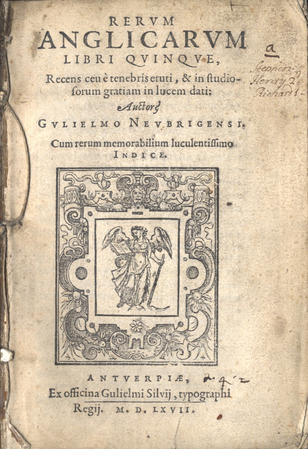1196 (ca.): The Undead Chaplain of Melrose Monastery
One of the earliest collections of English history was written in the 10th Century by William of Newburgh [ca. 1136-1198], and it covers the known history of England from around 1066 to William's death in 1198. The history was compiled from older history texts that William felt were reliable, and from verbal accounts of knowledgeable people in relation to more recent historic topics.

Title page of Historia Rerum Anglicarum [Larger version here]
Overall, William tried to give as accurate an accounting of the events he covered as he could... which is why the few places he choose to go off the topic of history in his texts are so intriguing. For example, in William's fifth volume of his Historia Rerum Anglicarum, he took time out to note the somewhat unusual matter of dead people rising from their graves at the time of his writing the text!
He didn't know how or why these matters were happening, but he had heard enough reports from channels and people he trusted that, for him, established it was in fact happening. William was intrigued not only by the reports, but also from the lack of such reports in the historic documents he had been consulting... so he concluded this was a new problem, not a repeating one. William gives details of four separate events, one of the which follows.
The Undead Chaplain of Melrose Monastery
A few years previous to his writing, William tells us, a chaplain associated with the Melrose Monastery passed away and was placed in a tomb in the monastery's graveyard. This chaplain was possessed of a particularly unsavory reputation for chasing ladies, despite his churchly occupation, and had so been nicknamed by many the 'Hundeprest', or "dog-priest." When he died, he had been in service to "a certain illustrious lady;" and it would seem he was preoccupied with her, even in death, for after his funeral he rose each night from his grave and generally hung out near the bedchamber of his former mistress, "with loud groans and horrible whispers."
It wasn't long before the lady implored one of the friars from the monastery, who had visited on a matter of business, to try to set the undead chaplain to rest. The friar agreed to help, as the lady was clearly terrified... though it also helped that she was a frequent donator to the monastery!
Upon his return to the monastery, the friar recruited another friar and "two powerful young men," and all went out to the cemetery to watch over the chaplain's grave for the night. Armed and courageous the four waited; but as midnight came and went, so too went some of their resolve. The second friar and the two young men soon went to a nearby house to warm themselves, leaving just the first friar to watch and wait at the grave... and, sure enough, as soon as the friar was alone he saw the chaplain rise from the grave and start towards him.
Despite initial fear and hesitation, the friar quickly steeled himself for the attack as the undead chaplain rushed at him with terrible noise and, as the monster reached him, the friar sank the axe he wielded deep into the body of the creature. The undead chaplain groaned from the wound, and turned to flee back to his grave as quickly as he had just rushed to attack the friar. The friar ran after, threatening to inflict a new wound upon the monster and compelling him to return to his tomb... and, strangely, the tomb opened of itself to receive the fleeing dead man, and then slammed shut before the friar could follow.
All this ruckus had caught the attention of the other friar and two young men who arrived far too late to help in the battle, but who were able to assist in the digging up of the chaplain's body when the first rays of sun started to light the countryside. The corpse possessed its new wound, inflicted outside the grave just hours before... and there was also a "great quantity of gore which had flowed from it in the sepulchre."
The body was carried beyond the walls of the monastery and burned, and its ashes were scattered to the winds... which presumably ended the matter, as no more was said of it. I personally find it interesting that the corpse was described as having apparently issued an unusual amount of 'gore,' given that it was only visiting one person, and it did not actually attack or harm anyone previous to the friar trying to catch it.
The Dating of the Event
Though a direct date is not given by William of Newburgh for this strange events, he does say it occurred 'a few years ago' to the time of his writing... and many historians believe this section of the histories was written around 1196, as this is when other events William discusses in this part of his history took place.
Anomalies -- the Strange & Unexplained, as well as my other website -- Monsters Here & There -- are supported by patrons, people like you! All new Anomalies articles are now posted for my patrons only, along with exclusive content made just for them. You can become a patron for just $1 a month!
|








